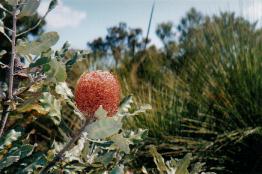
WILDFLOWER
for violin & piano
| The composer’s journey into the West Australian bush during the spring season brought him in contact with something uniquely Australian: the wildflower species “Banksia” - a thorny shrub which in flower produces many from white- over yellow- to red-colored cone-shaped spikes containing hundreds of individual tiny blossoms. The fascinating lifecycle of this plant evolved into the formal structure of a composition for violin and piano. |
|
After a short and very tonal introduction of the violin the piano is coming in with an important ostinato pedal point, symbolizing time. It is the starting point of a huge built up as if in Western Australia the spring rains fall and the flora begins to grow. We will hear a lyrical theme in the high register of the violin over prelude-like arpeggios and harmonies from the piano. All material, for the theme and for the accompaniment, is taken from symmetric interval relationships –symmetric like the leaves, spikes and blossoms of the wildflower itself and this material will form the whole piece, both in tonal or more chromatic context.
|
|
As the flower is developing the music gets more intense and energetic until we reach the first dynamic climax, full six part chords over very strong and low basses in the piano with agitating violin lines, also built on the equivalent hexatonic scale. This section represents the flowering of the plant when it is in full color and the spikes show all of their blossoms. |
The descent from here shows the wilt of the flower in a long and lyrical decrescendo interweaving melodic fragments from the theme. Now the style of the music changes from tonal into a more chromatic idiom to describe what is left of the former flowery spikes: only hard and dry dark brown cones. Like in the beginning the music suggests passing time in form of a continuous repetitive note on which a new crescendo starts to build.
| The menacing dissonance of the following interaction between violin and piano anticipates what often happens in the heat of the Australian bush: fire is devastating huge parts of the flora. The blazing flames of a raging fire are imitated by a turbulent dynamic and atonal climax during which the violin plays wild glissandi and the piano mixes both whole-tone scales over sustained pedal. |
|
|
|
In the middle of the inferno something remarkable happens to the cones of the burning wildflower: they begin to crack under the enormous heat and let their seeds come out into the open. This cracking of the cones is demonstrated in the music by a solo violin cadenza, using some very special pizzicato effects.
|
Now the cycle of the wildflower can begin anew what is shown in a short and again tonal finale of the piece, reminding us of the lyrical theme and bringing it to an at least temporarily end.